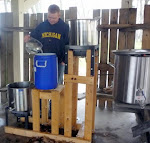
Belgian Beer PrimerDecoding the world’s most acclaimed
(and confusing) brews
By Roxanne Webber
http://www.chow.com/stories/11362/
Belgian beer has mystique: Some of it’s made by monks. Some of it tastes really, really weird. Some of its labels show elves and devils. People who know beer are sometimes unable to resist blowing huge chunks of cash on it. How to Serve Belgian Beer
and Where to Try It
It is, said famed beer writer Michael Jackson, the “Disneyland of beer.”
But like Disneyland on a warm holiday weekend, Belgian beer can be intimidating. Walk into a specialty shop or bar that stocks it, and you’ll probably be confronted with an overwhelming list of things you’ve never heard of—with names in French, Dutch, or a combination of the two. The beers will often be more expensive than other imports, and in some cases will deliver flavors the average American palate is unprepared for. It’s enough to make most of us just order a Sierra.
Still, Belgian beer is wonderful, and it can take you places you never expected. The range of flavors and aromas, like with wine, can be surprisingly complex and mysterious. To dive in, all you need is a little background and the curiosity to begin tasting. Whether you’re a fan of rich, dark ales or light, effervescent quaffers, there are delightful examples to be found. We’ve put together this primer on the various styles and where to locate them stateside to get you started.
MAIN STYLES
Not all Belgian beer is craft beer: Belgians drink crappy beer sometimes just like Americans do. And among the craft options there’s a fallacy, says Dan Shelton, owner of Shelton Brothers, one of the primary importers of small-batch Belgian beers for the U.S. market, which is that they’re all ultrasweet, strong, spicy, or fruity, rather than hoppy or light. Not true.
Saison
Historically, saisons were made on farms with whatever grains were on hand to supplement the malted barley, so there was a lot of variation. (“Malted” means the grain has been moistened, allowed to germinate—which makes its starches more readily available for the brewing process—and then heated to stop it from sprouting.) They are refreshing, light in body, dry, golden to orange in color, effervescent, relatively low in alcohol (around 5 percent), and moderately hoppy. They may or may not have spices added (some take on a spicy flavor naturally from phenols produced during fermentation), and can be citrusy and floral.
TRY: Saison Dupont; Fantôme
Witbier or Bier Blanche
These are Belgian-style wheat beers made with a relatively high percentage of unmalted (raw) wheat and some lightly malted barley. Witbiers are pale to golden in color but can be cloudy because they’re unfiltered. Most, like Hoegaarden, are flavored with coriander and orange peel, but they don’t have to be. Like German hefeweizens, witbiers are refreshing, citrusy, relatively low in alcohol (4 to 5 percent), and easy to drink.
TRY: Vuuve 5 (spiced); Saisis Blanche (unspiced)
Trappist/Abbey
Trappist beers are brewed by a Benedictine order of monks. The tradition of creating products like beer, cheese, and bread dates back to 1098, to fund social work and make the monasteries self-sufficient. There are Trappist monasteries all over the world, but only seven brew beer, six of them in Belgium: Achel, Orval, Scourmont Lez Chimay, Rochefort, Westmalle, and Westvleteren. The seventh, Koningshoeven, is located in the Netherlands. You’ll often see Trappist beers labeled “double” or “triple,” and sometimes “single” or “quadruple.” The terms indicate alcohol content (double is stronger than single, etc.). Some Trappist breweries, like Rochefort and Westvleteren, skip this naming convention and use numbers; higher numbers indicate higher alcohol content (though they don’t directly correlate to the actual percentage).
“Abbey” is a term applied to beers made in the Trappist styles but not necessarily in an abbey. There are no regulations for what these styles should taste like, so they vary greatly. Here’s a rough generalization of what to expect:
SINGLE A.K.A. SINGEL: There aren’t very many singles, but the ones you can find are lighter, easier-drinking beers, almost like pale ales, with 4 to 5 percent alcohol.
TRY: Witkap-Pater Singel (not from a Trappist monastery)
DOUBLE A.K.A. DUBBEL: Between 5 and 8 percent alcohol, often amber to brown, with a malty aroma and flavors like raisin, fig, date, caramel, plum, and even toffee and chocolate. They can be on the sweet side.
TRY: Westmalle Dubbel
TRIPLE A.K.A. TRIPEL: Usually a strong golden ale, around 8 to 9 percent alcohol. Triples are fruitier and crisper than doubles, and often more refreshing.
TRY: Achel 8° Blonde; Orval (a unique Trappist brew similar to a triple but considered a Belgian pale ale by some)
QUADRUPLE: Very high in alcohol content (10 to 12 percent), sweet and raisiny, sometimes chocolaty. Kind of like a double on steroids.
TRY: Urthel Samaranth (not from a Trappist monastery)








